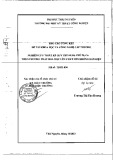
Genome Biology 2008, 9:R88
Open Access
20 0 8Scholz an d FraunholzVolume 9, Issue 5, Article R88
Research
A computational model of gene expression reveals early
transcriptional events at the subtelomeric regions of the malaria
parasite, Plasmodium falciparum
Matthias Scholz and Martin J Fraunholz
Address: Com peten ce Center for Functional Genomics, Ern st-Moritz-Arndt University, Friedrich-Ludwig-J ahn Strasse, D-17487 Greifswald,
Germany.
Correspon dence: Matthias Scholz. Em ail: Matthias.Scholz@uni-greifswald.de
© 2008 Scholz and Fraunholz; licensee BioMed Central Ltd.
This is an open access article distributed under the terms of the Creative Commons Attribution License (http://creativecommons.org/licenses/by/2.0), which
permits unrestricted use, distribution, and reproduction in any medium, provided the original work is properly cited.
Subtelom eric early tran scription in Plasmodium<p>A mathem atical model of the intraerythrocytic developmental cycle identifies a delay between subtelomeric and central chromosom al gene activities in the malar ia parasite, <it>Plasm odium falciparum</ it>.</ p>
Abstract
Background: The malaria parasite, Plasmodium falciparum, replicates asexually in a well-defined
infection cycle within human erythrocytes (red blood cells). The intra-erythrocytic developmental
cycle (IDC) proceeds with a 48 hour periodicity.
Results: Based on available malaria microarray data, which monitored gene expression over one
complete IDC in one-hour time intervals, we built a mathematical model of the IDC using a circular
variant of non-linear principal component analysis. This model enables us to identify rates of
expression change within the data and reveals early transcriptional events at the subtelomeres of
the parasite's nuclear chromosomes.
Conclusion: A delay between subtelomeric and central gene activities suggests that key events of
the IDC are initiated at the subtelomeric regions of the P. falciparum nuclear chromosomes.
Background
The protozoan parasite Plasm odium falciparum causes
malaria in humans. The life cycle of Plasm odium includes
multiple stages of developm en t that take place in the mos-
quito vector and, upon infection of hum ans, in liver and red
blood cells (RBCs). In erythrocytes, the malaria parasites
undergo an asexual reproductive cycle (the intra-erythrocytic
developm ent cycle (IDC)), which is responsible for pathogen-
esis in humans. After invasion of RBCs, merozoites establish
a rin g-like form within the parasitophorous vacuole, which
develops to form the trophozoite stage during which the par-
asite is feeding on hem oglobin. After multiple replications of
the parasite genom e, trophozoite cell com ponents are pack-
aged into m ultiple schizonts and, upon rupture of the RBC
mem brane, m ature m erozoites are released, each of which
will re-initiate a new IDC. Bozdech et al. [1] and Llinas et al.
[2] presen ted highly tim e-resolved microarray analyses of the
transcriptom es of P. falciparum strains HB3, 3D7, and Dd2
during their IDC. In these analyses most genes were shown to
behave in a sinusoidal fashion, with one peak of strong up-
regulation and one dip in the expression data. This cyclic
behavior prom pted us to analyze these transcriptome data in
order to iden tify genes that involve a circular compon ent in
data space. To m odel the infection cycle and obtain the rate of
chan ge for each gene at any time, we built a mathematical
model of the IDC by using a non -linear dimensionality reduc-
tion technique based on neural networks, term ed circular
principal com ponent analysis (PCA) [3]. The model provides
Published: 27 May 2008
Genome Biology 2008, 9:R88 (doi:10.1186/gb-2008-9-5-r88)
Received: 25 January 2008
Revised: 21 April 2008
Accepted: 27 May 2008
The electronic version of this article is the complete one and can be
found online at http://genomebiology.com/2008/9/5/R88






























